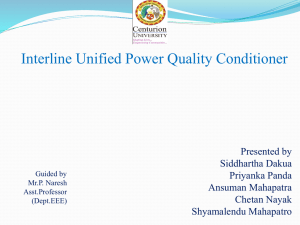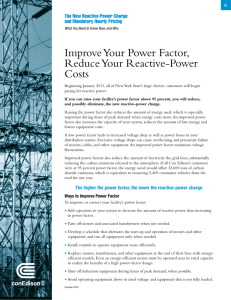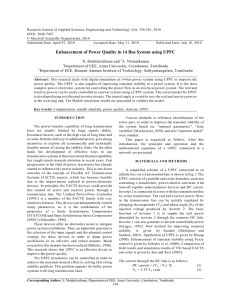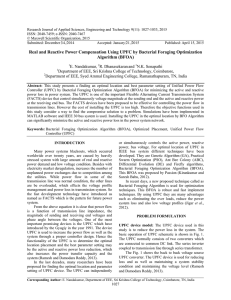Document 13134665
advertisement
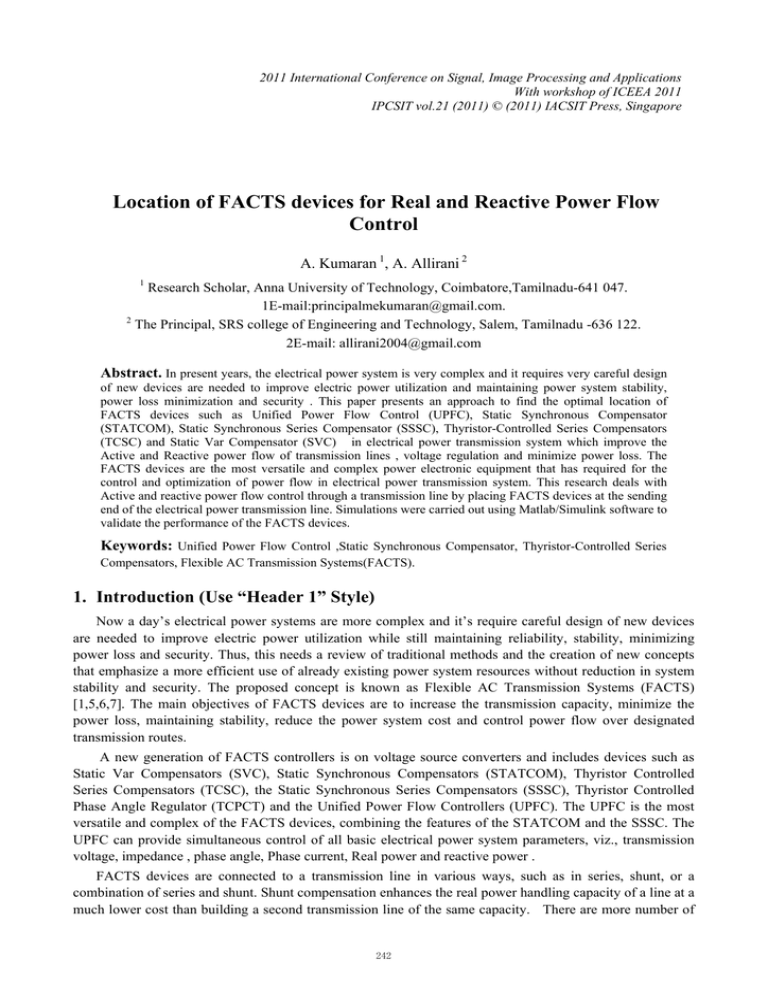
2011 International Conference on Signal, Image Processing and Applications With workshop of ICEEA 2011 IPCSIT vol.21 (2011) © (2011) IACSIT Press, Singapore Location of FACTS devices for Real and Reactive Power Flow Control A. Kumaran 1, A. Allirani 2 1 Research Scholar, Anna University of Technology, Coimbatore,Tamilnadu-641 047. 1E-mail:principalmekumaran@gmail.com. 2 The Principal, SRS college of Engineering and Technology, Salem, Tamilnadu -636 122. 2E-mail: allirani2004@gmail.com Abstract. In present years, the electrical power system is very complex and it requires very careful design of new devices are needed to improve electric power utilization and maintaining power system stability, power loss minimization and security . This paper presents an approach to find the optimal location of FACTS devices such as Unified Power Flow Control (UPFC), Static Synchronous Compensator (STATCOM), Static Synchronous Series Compensator (SSSC), Thyristor-Controlled Series Compensators (TCSC) and Static Var Compensator (SVC) in electrical power transmission system which improve the Active and Reactive power flow of transmission lines , voltage regulation and minimize power loss. The FACTS devices are the most versatile and complex power electronic equipment that has required for the control and optimization of power flow in electrical power transmission system. This research deals with Active and reactive power flow control through a transmission line by placing FACTS devices at the sending end of the electrical power transmission line. Simulations were carried out using Matlab/Simulink software to validate the performance of the FACTS devices. Keywords: Unified Power Flow Control ,Static Synchronous Compensator, Thyristor-Controlled Series Compensators, Flexible AC Transmission Systems(FACTS). 1. Introduction (Use “Header 1” Style) Now a day’s electrical power systems are more complex and it’s require careful design of new devices are needed to improve electric power utilization while still maintaining reliability, stability, minimizing power loss and security. Thus, this needs a review of traditional methods and the creation of new concepts that emphasize a more efficient use of already existing power system resources without reduction in system stability and security. The proposed concept is known as Flexible AC Transmission Systems (FACTS) [1,5,6,7]. The main objectives of FACTS devices are to increase the transmission capacity, minimize the power loss, maintaining stability, reduce the power system cost and control power flow over designated transmission routes. A new generation of FACTS controllers is on voltage source converters and includes devices such as Static Var Compensators (SVC), Static Synchronous Compensators (STATCOM), Thyristor Controlled Series Compensators (TCSC), the Static Synchronous Series Compensators (SSSC), Thyristor Controlled Phase Angle Regulator (TCPCT) and the Unified Power Flow Controllers (UPFC). The UPFC is the most versatile and complex of the FACTS devices, combining the features of the STATCOM and the SSSC. The UPFC can provide simultaneous control of all basic electrical power system parameters, viz., transmission voltage, impedance , phase angle, Phase current, Real power and reactive power . FACTS devices are connected to a transmission line in various ways, such as in series, shunt, or a combination of series and shunt. Shunt compensation enhances the real power handling capacity of a line at a much lower cost than building a second transmission line of the same capacity. There are more number of 242 factors that can be affecting the performance of a electrical power transmission system. Main problems which cause instability to a power system is voltage stability. Voltage stability has been defined as the ability of a system to maintain voltage so that when load admittance is increased, load power will increase and both power and voltage can be controlled. The main cause of voltage instability is insufficient reactive power supply. Properly planned reactive reserve will provide adequate reactive power support at critical buses [6]. 2. Power Flow Control of UPFC The basic components of the UPFC are two voltage source inverters (VSIs) sharing a common dc storage capacitor, and connected to the power system through coupling transformers. One VSI is connected to in shunt to the transmission system via a shunt transformer, while the second VSI is connected in series with line through a series transformer. A basic UPFC functional scheme[10] is shown in fig.l. Fig. 1 Basic functional scheme of UPFC The series inverter is controlled to inject a symmetrical three phase voltage system (Vse), of controllable magnitude and phase angle in series with the line to control active and reactive power flows on the transmission line. So, this inverter will exchange active and reactive power with the line. The reactive power is electronically provided by the series inverter, and the active power is transmitted to the dc terminals. The shunt inverter is operated in such a way as to demand this dc terminal power (positive or negative) from the line keeping the voltage across the storage capacitor Vdc constant. So, the net real power absorbed from the line by the UPFC is equal only to the losses of the inverters and their transformers. The remaining capacity of the shunt inverter can be used to exchange reactive power with the transmission line so to provide a voltage regulation and security at the connection point. The two VSIs are can working independently of each other by separating the dc side. So in that case, the shunt inverter is operating as a STATCOM that generates or absorbs reactive power to regulate the voltage magnitude at the connection point. Instead, the series inverter is operating as SSSC that generates or absorbs reactive power to regulate the current flow, and hence the power flows on the transmission line. 3. Mathematical model of UPFC The basic structure and operation of the UPFC can be represented through the model[10] shown in fig.2. The transmission line parameters are as shown in Table I Fig.2 Mathematical model of UPFC In this model, we have considered the UPFC is placed at the centre of a 100km transmission line. The equations for sending end active and reactive power can be obtained from the real and imaginary powers of power equation as follows: Ps=R(Vs ∠ δI)=0.256+0.482sin(δb- δ)-0.256cos δ+2.72sin δ+0.08cos(δb- δ) 243 Qs=Im[z ∠ δI] =2.65-2.65cos δ+0.48cos (δ- δb)+0.08sin(δb- δ)-0.256sin δ The variation limits of δb and δ are according tothe following relation: 0 ≤ δb ≤ 2Π 0 ≤ δ ≤ 0.71 radians The maximum limit of δ is chosen according to the stability margin [9]. The variation of sending end active and reactive powers by varying δb and δ is obtained through MATLAB. 4. Control Structure of UPFC The superior operating characteristics of the UPFC are due to its unique ability to inject an ac compensating voltage vector with arbitrary magnitude and angle in series with the line upon command, subject only to equipment rating limits. With suitable electronic controls, the UPFC can cause the seriesinjected voltage vector to vary rapidly and continuously in magnitude and/or angle as desired. Thus, it is not only able to establish an operating point within a wide range of possible P, Q conditions on the line, but also has the inherent capability to transition rapidly from one such achievable operating point to any other. The control of the UPFC is based upon the vector-control approach(i.e., for STATCOMs). The term vector, instead of phasor, is used in this section to represent a set of three instantaneous phase variables, voltages, or currents that sum to zero. The symbols V and I are used for voltage and current vectors. For the purpose of power control it is useful to view these vectors in an orthogonal coordinate system with p and q axes such that the p axis is always coincident with the instantaneous voltage vector v and the q axis is in quadrature with it. In this coordinate system the p-axis current component, ip, accounts for the instantaneous real power and the q-axis current component, iq, for the reactive power. Fig.3. Overall UPFC control structure Under balanced steady-state conditions, the p-axis and q-axis components of the voltage and current vector are constant quantities. This characteristic of the described vector representation makes it highly suitable for the control of the UPFC by facilitating the decoupled control of the real and reactive current components. "The UPFC control system may, in the previously established manner, be divided functionally into internal (or converter) control and functional operation control. The internal controls operate the two converters so as to produce the commanded series injected voltage and, simultaneously, draw the desired shunt reactive current. The external or functional operation control defines the functional operating mode of the UPFC and is responsible for generating the internal references, VpqRef and IqRef, for the series and shunt compensation to meet the prevailing demands of the transmission system. The functional operating modes and compensation demands, represented by external (or system) reference inputs, can be set manually (via a computer keyboard) by the operator or dictated by an automatic system optimization control to meet specific operating and contingency requirements. An overall control structure, showing the internal, the functional operation, and system optimization controls with the internal and external references is presented in Figure 3[1,2,3,4].The capability of unrestricted series voltage injection together with independently controllable reactive power exchange offered by the circuit structure of two back-to-back converters, facilitate several operating and control modes for the UPFC. 244 5. Simulation Setup in MATLAB Fig. 4 shows the simulation model including a power system with a transmission line[9,10]. The UPFC installed near the sending end effectively controls the power flow from sending end to the receiving end. Fig. 4. Power system study model Here, Vs and Vr are assumed to be sending and receiving-end voltages. This model assumes that sending end corresponds to a power plant while the receiving end to an electric power network, i.e., SMIB system. The receiving end voltage may not cause any phase angle change, because Vr is an infinite bus voltage. The phase angle of Vs is adjusted according to the power demand for the power plant. A phase difference of 100 between sending-end and receiving end voltages is simulated. The main circuit of the series device (SSSC) consists of a three phase PWM inverter, the ac terminals of which are connected in series to a transmission line through three single phase transformers. The shunt device (STATCOM) consists of a three phase PWM inverter, the ac terminals of which are connected in parallel with the transmission line via a three phase star-delta transformer. In this simulation, the shunt inverter operates in automatic voltage control mode. Similarly, AC voltage from the sending end bus feeding the shunt coupling transformer is measured in p.u, (Vpum) and compared with the AC voltage set point (here 1.0 p.u), whose error is fed to PI controller to generate modulation index, mi. 6. Power Flow Control of STATCOM and SSSC This chapter presents the operating principles and applications of several highly versatile controllers are the STATCOM, SSSC, and UPFC without any prejudice to other FACTS controllers [1,8]. These three FACTS controllers are second generation types that are based on non Thyristor devices such as Gate TurnOffs (GTOs) and Insulated-Gate Bipolar Transistors (IGBTs). STATCOM (or SSC) is a shunt-connected reactive-power compensation device that is capable of generating and/or absorbing reactive power and in which the output can be varied to control the specific parameters of an electronic power system. A STATCOM can improve power-system performance in dynamic voltage control in transmission and distribution systems, Power-oscillation damping in powertransmission systems, Transient stability, Voltage flicker control and Control of not only reactive power but also (if needed) active power in the connected line requiring a dc energy source. A STATCOM is a controlled reactive-power source. It provides he desired reactive-power generation and absorption entirely by means of electronic processing of the voltage and current waveforms in a voltagesource converter (VSC) and VSC is connected to a utility bus through magnetic coupling. STATCOM is seen as an adjustable voltage source behind a reactance meaning that capacitor banks and shunt reactors are not needed for reactive-power generation and absorption, thereby giving a STATCOM a compact design, or small footprint, as well as low noise and low magnetic impact. The exchange, of reactive power between the converter and the ac system can be controlled by varying the amplitude of the 3-phase output voltage, Es of the converter. That is, if the amplitude of the output voltage is increased above that of the utility bus voltage, then a current flows through the reactance from the converter to the ac system and the converter generates capacitive-reactive power for the ac system. If the amplitude of the output voltage is decreased below the utility bus voltage, then the current flows from the ac system to the converter and the converter absorbs inductive-reactive power from t ac system. In other words, 245 the converter can supply real power to the ac system from its dc energy storage if the converter-outputvoltage is made to lead the ac-system voltage. STATCOM provides the desired reactive power exchanging the instantaneous reactive power by among the phases of the ac system. Adjusting the phase shift between the converter-output voltage and the ac system voltage can similarly control real-power exchange between the converter and the ac system. On the other hand, it can absorb real power from the ac system for the dc system if its voltage lags behind the acsystem voltage. A STATCOM provides the desired reactive power exchanging the instantaneous reactive power by among the phases of the ac system. 7. Simulation Results A transmission line of a simple power system with parameters as given in Table 1[10] is considered. UPFC is placed in series with the transmission line at the sending end. Voltage, active power, reactive power and current variations in the transmission line with UPFC and without UPFC are studied. The power system studied is SMIB system, when the transmission line is without UPFC, the sending-end and receiving-end voltages are as shown in fig. 5(a)&(b). When UPFC is placed across the same transmission line, the voltage regulation is improved as per fig 6. (a)With UPFC (b) Without UPFC Fig. 5. Sending end and Receiving end voltages Fig.6. Receiving end voltage With UPFC In this simulation, the theta order input to the series inverter control circuit is 50.By varying the theta order input to the controller the phase and magnitude of the series injected voltage can be varied. When the transmission line is without UPFC, the real and reactive power flow cannot be controlled. Fig.7 (a) shows the active power through the line with UPFC. Fig.7 (b) shows the active power flow through line without UPFC. Transmission capability of the existing transmission line is highly improved with the presence of UPFC. But the difference between the sending end real power and receiving end real power is high in the transmission line with UPFC. This is due to the increase in transmission losses, which include losses in the both converters and coupling transformers. 246 (a)With UPFC (b) Without UPFC Fig. 7. Receiving end active power (a)With UPFC (b) Without UPFC Fig. 8. Receiving end reactive power The reactive power flow through the transmission line with and without UPFC is shown fig. 8.The raise in the transmission capability is noticed from the simulation results. The power transfer capability of long transmission lines is usually limited by their thermal capability. Utilizing the existing transmission line at its maximum thermal capability is possible with UPFC. Fig.9.Sending end voltage with SSSC Fig.10.Receiving end voltage with SSSC Fig. 11. Receiving end reactive and active power with STATCOM 247 The current through phase A of the transmission line with UPFC, it raise in the transmission capability of the transmission line. The current transfer capability of long transmission lines is usually limited by their thermal capability. Utilizing the existing transmission line at its maximum thermal capability is possible with UPFC. The Sending end and Receiving end voltages with SSSC are shown in fig.9&10.The receiving end reactive and active power of the transmission line with STATCOM is shown in fig 11. The raise in the transmission capability is noticed from the simulation results. TABLE 1. SYSTEM PARAMETER Line to line voltage 1000 kV Frequency 50 Hz Transmission rating 100 MVA Capacitance of DC link Capacitor 1500µF DC link voltage 50kV Length of the transmission line 400km Resistance of the line 32 µΩ/m Inductive reactance of the line 350.3 µΩ/m Capacitive reactance of the line 274.5 MΩ/m 8. Conclusion In this research, the MATLAB environment is used to simulate the model of FACTS controllers connected to a three phase-three wire transmission system. This research paper presents control and performance of FACTS devices intended for installation on a transmission line. This FACTS control system is simulated with shunt inverter in AC and DC voltage control mode and series inverter in open loop phase angle control mode. Simulation results show the effectiveness of FACTS controllers in controlling real and reactive power through the transmission line. Due to the AC voltage controller, AC voltage regulation has improved. The DC voltage controller maintains the DC link voltage to the DC voltage set point about 50 kV. This technique improved in the real and reactive power flow through the transmission line with FACTS devices when compared to the system without FACTS devices. 9. Reference [1] N. G. Hingorani and L. Gyugyi, Understanding FACTS, Concepts, and Technology of Flexible AC Transmission Systems. Piscataway, NJ: IEEE Press, 2000. [2] Eskandar Gholipur and Shahrokh Saadate, "Improving of Transient Stability is Power Systems Using UPFC" IEEE Trans. Power Del., vol. 20, no. 2, pp. 1677-1682, Apr. 2005. [3] Q. Yu, S. D. Round, L. E. Norum, T. M. Undeland, "Dynamic Control of a Unified Power Flow Controller," IEEE Trans. Power Del., vol. 9, no. 2, pp.508-514, Apr. 1996. [4] H. Fujita, Y. Watanabe and H. Akagi, "Control and Analysis of a Unified Power Flow Controller," IEEE Trans. Power Elect, vol. 14, no. 6, pp.1021-1027, Nov. 1999. [5] H. Fujita, Y. Watanabe and H. Akagi, "Dynamic Control and Performance of a Unified Power Flow Controller for Stabilizing an AC Transmission System," IEEE Trans. Power Elect, vol. 21, no. 4, pp.1013-1020, July,.2006. [6] N.P.Pathy, M.A.Abdel Moamen, “Power flow control and solutions with multiple and multi type FACTS devices,” Electric power system research(October)(2004) [7] A .A. Edris, R. Aapa, M.H. Baker, L. Bohman, K. Clark, "Proposed terms and definitions for flexible ac transmission system (FACTS)", IEEE Tran. on power delivery Vol. 12, No. 4, Oct. 1997. [8] V. K. Chandrakar, A.G. Kothari, "Optimal Location for Line Compensation by Shunt Connected FACTS Controller" The Fifth International Conference on Power Electronics and Drive Systems, PEDS 2003, Vol. 1, Page(s): 151 – 156, 17-20 Nov. 2003. [9] H. I. Shaheen, G. I. Rashed, and S. J. Cheng, “Optimal Location and Parameters Setting of Unified Power Flow Controller Based on Evolutionary Optimization Techniques”, IEEE PES 2007 General Meeting, 2007, pp. 1-8. [10] S. Tara Kalyani and G. Tulasiram Das “Simulation of real and Reactive Power Flow Control With UPFC 248





